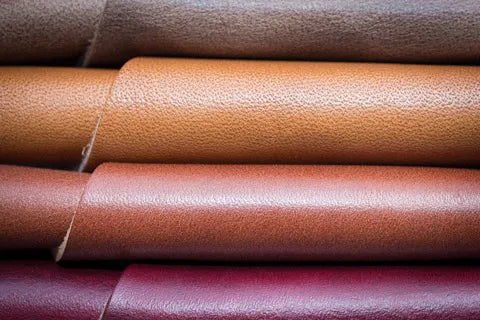
CHROMEXCEL from Horween Leather Company
Nick Horween, vice president of the famous Chicago-based Horween Leather factory, talks about a superior material for shoes, jackets, and accessories - Chromexcel leather.
Chromexel is one of my favorites - maybe even the most favorite material when the question of choice comes up. It was introduced so long ago that there are hardly any records saved - around 1913. Not even the original recipe has survived - only the modifications to the original technology. Thanks to the successful initial recipe - or maybe due to our stubbornness - we've kept the original process and formulas pretty much the same for most of our skins. Some ingredients used in the process in small quantities have had to be replaced - for example, whale oil has been replaced with another marine fat that is more available and less controversial.
WHAT IS CHROMEXCEL
Chromexcel, or CXL as it is labeled on the front of our building, is a combi-tanned leather that has undergone around 89 processes over 28 days on all five floors of our factory. Do I need to explain how complex this process is? Any tanning process requires a certain degree of ‘cooking’. By this, I mean that from batch to batch the tanning process can vary slightly. This variation is due to the fact that, with many components undergoing many processing steps, the aim is to produce a final result that is as uniform and stable as possible.
Additional challenges are caused by the nature of the raw material - the hides - each of which, as a by-product of the meat industry, is unique. Finishing agents from tree bark, dyeing agents from natural pigments - all mixed together and processed using heat, steam, pressure, manual labour, and, most importantly, time.
MATERIAL PREPARATION
The process begins with the arrival of a new batch of hides from one of our local suppliers: the hides are salted, ‘hairy’, rolled up, and stacked on pallets. We inspect the delivery, ‘split’ the hides (i.e. cut them in half, as we work with halves, not whole hides), and put them away for further processing: we need to debark, soften, etch, and tan our hides. Hair stripping takes place in a large drum like a concrete mixer, where a solution is poured in, which ‘burns’ all the hair down to the follicles.
After removing the hair, the mixer is doused with lime (for the second time so far) to stop the reaction, then dried and rinsed.
The next step is furbearer removal when the inside of the skin is cleaned of any suspicious elements. This also helps to prepare the skin for further processing - softening, etching, and tanning.
Softening and etching are the first steps in the preservation process and prepare the hide for basic tanning. In the case of chromexel, the base element is chromium, in the form of chromium salts. The process itself is chemically complex and requires a specific concentration of substances, a strict temperature regime, a precise time period, and the right level of acidity. The process runs continuously throughout the week, with our operators working in shifts from Monday morning to Friday evening. At the end of this period, we have hidden the characteristic ‘wet blue’ color as a result of chrome tanning. Up to this point, the process is quite standard, except for our special tanning formulas, and many producers operate in a similar way.
Then things get more interesting. The skins go through a quality selection process: grain, weight/thickness, scratches, scars, stamps, etc. Then the process of finishing begins - and this is where our secrets start.
We carry out tannin (vegetable) tanning of Chromexel and many other hides, such as Cordovan, using a special proprietary mixture of bark extracts and natural pigments. The advantages of combined tanning are the result of the special qualities of both chrome and vegetable elements. Normally, chrome-tanned leathers are soft, flexible, and strong, whereas vegetable-tanned leathers are rough to the touch and can be easily shaped under heat and humidity.
GREASING WITH ANIMAL FATS
The next step is ‘hot greasing’ or impregnating the hides with oils, waxes, and lubricants that are solid at room temperature. Greasing is carried out by means of steam machines and serves, among other things, to stretch the skin. During stretching, the fat mixtures are temporarily displaced, resulting in a lighter leather. At this stage, our approach is particularly applicable - to produce the best leather, the best components must be used: in our case, it is food-grade beef fat and cosmetic beeswax.
LEATHER-HAND PROCESSING
Now when the basics are ready, you can start the finishing process. Chromexel is treated several times by hand with aniline. In this way, the skins are evenly colored.
For the most part, the leather is considered almost ready at this point: now it has to be sorted, labelled, packaged, and shipped to customers. The final touch is a layer of bone oil. I always recommend using this product when people ask me how to care for Chromexcel leather.
CHROMEXCEL TYPES
There are numerous varieties of chromexel: Wooly, Beaufort, Cavalier, Plainsman, Huntsman, Kudu, and Horsefront to name just a few. Each of them was created for a specific purpose and with appropriate parameters, but most of the technological processes and recipes are the same, and the same experienced craftsmen work with them. I never get tired of repeating and I can repeat one more time - the quality of our product is to a great extent the merit of our employees.